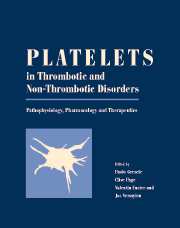Book contents
- Frontmatter
- Contents
- List of contributors
- Editors' preface
- PART I PHYSIOLOGY
- PART II METHODOLOGY
- PART III PATHOLOGY
- PART IV PHARMOLOGY
- 61 Aspirin
- 62 Pharmacology of ticlopidine and clopidogrel
- 63 Platelet membrane glycoprotein (GP) IIb–IIIa antagonists and acute arterial thrombosis
- 64 Other antiplatelet agents
- 65 Pharmacogenetics as a new antiplatelet strategy
- 66 Cardiovascular gene therapy: implications for platelet vessel wall interactions
- 67 Pharmacological modulation of the inflammatory actions of platelets
- PART V THERAPY
- Afterword: Platelets: a personal story
- Index
- Plate section
62 - Pharmacology of ticlopidine and clopidogrel
from PART IV - PHARMOLOGY
Published online by Cambridge University Press: 10 May 2010
- Frontmatter
- Contents
- List of contributors
- Editors' preface
- PART I PHYSIOLOGY
- PART II METHODOLOGY
- PART III PATHOLOGY
- PART IV PHARMOLOGY
- 61 Aspirin
- 62 Pharmacology of ticlopidine and clopidogrel
- 63 Platelet membrane glycoprotein (GP) IIb–IIIa antagonists and acute arterial thrombosis
- 64 Other antiplatelet agents
- 65 Pharmacogenetics as a new antiplatelet strategy
- 66 Cardiovascular gene therapy: implications for platelet vessel wall interactions
- 67 Pharmacological modulation of the inflammatory actions of platelets
- PART V THERAPY
- Afterword: Platelets: a personal story
- Index
- Plate section
Summary
Introduction
The thienopyridines ticlopidine and clopidogrel have a closely related chemical structure and similar pharmacological activity. In vivo, an active metabolite of these drugs is generated which selectively inhibits adenosine-5'diphosphate (ADP)-induced platelet aggregation and the ADP-mediated amplification of platelet responses to other agonists. This selective effect is due to irreversible covalent modification by the active metabolite of the recently cloned purinergic P2 receptor of platelets, P2Y12. As a result, ticlopidine and clopidogrel were the first P2Y12 inhibitors to be used clinically as antithrombotic drugs. These compounds have proved to be safe and highly efficacious in preventing the thrombotic complications of atherosclerotic vascular disease in the brain, heart and peripheral arteries. In addition, they are useful molecular probes of the P2Y12 receptor and have permitted progress in our understanding of the role of ADP in platelet activation and vascular thrombosis.
ADP was identified in the early 1960s as a factor released from erythrocytes which influenced platelet adhesiveness to glass and induced platelet aggregation. The crucial role of ADP as a mediator of platelet activation was rapidly recognized in relation to both the physiological process of hemostasis and the development and extension of arterial thrombosis. ADP is present at very high concentrations in platelet dense granules and is released when platelets are exposed to thrombin, collagen or thromboxane A2 (TXA2), thus reinforcing their aggregation.
- Type
- Chapter
- Information
- Platelets in Thrombotic and Non-Thrombotic DisordersPathophysiology, Pharmacology and Therapeutics, pp. 929 - 939Publisher: Cambridge University PressPrint publication year: 2002
- 3
- Cited by



